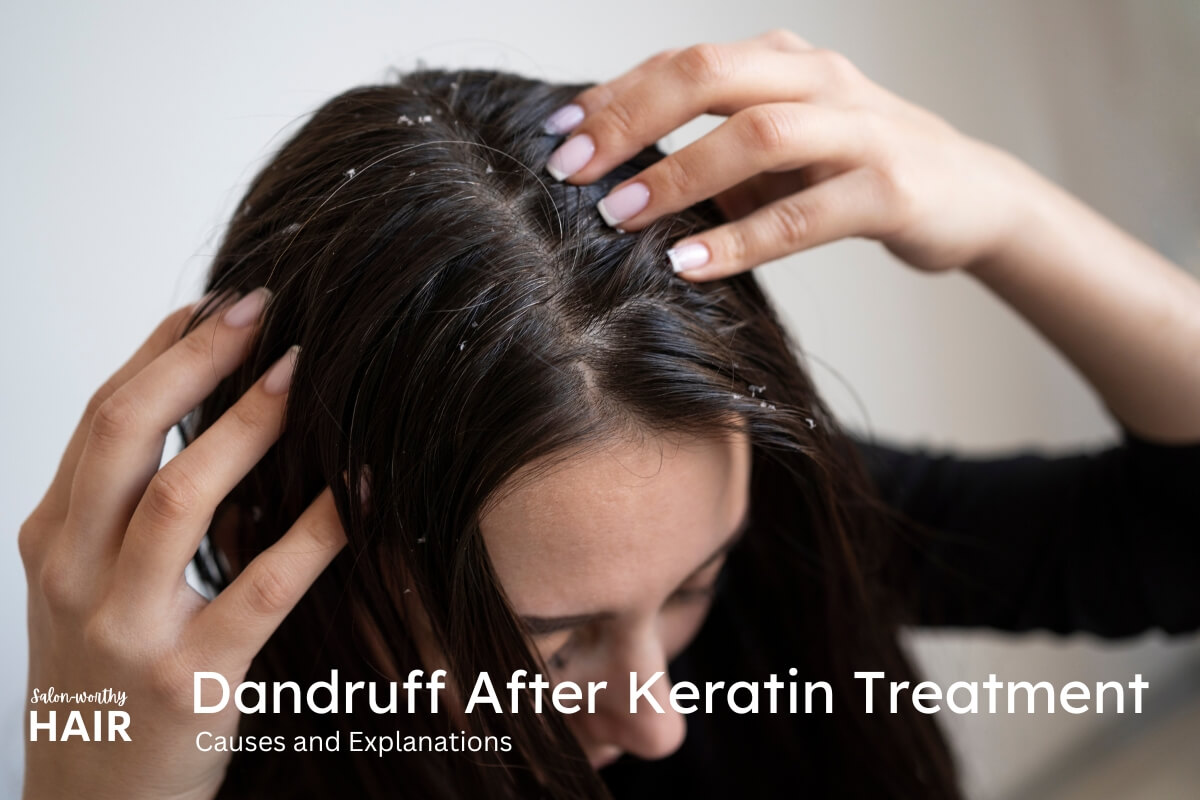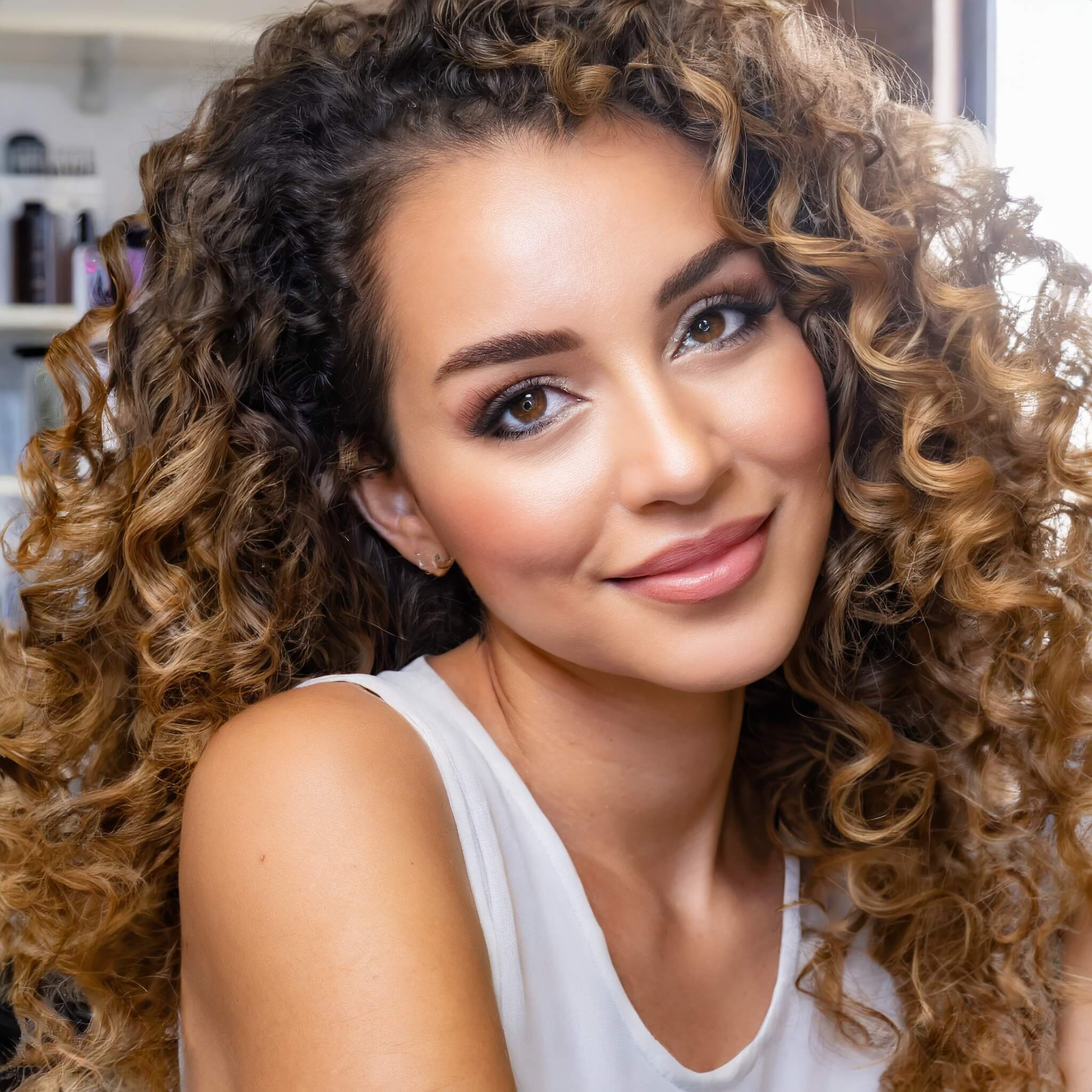Dandruff and Dry Flaky Scalp After Keratin Treatment: Causes and Explanations
Updated on
This post may contain affiliate links. As an Amazon Associate, we may earn from qualifying purchases.

Dandruff after a keratin treatment can feel like a frustrating betrayal, especially when you’ve invested in a salon treatment to get sleek and smooth hair.
Sometimes, it can feel like your entire scalp is flaking, itching, and peeling off with thick flakes that appear glued to the hair.
It’s a common misconception that keratin treatments cause dandruff, but the reality is more complex.
Your scalp might react to the chemicals in the treatment, feeling stripped of natural oils or overwhelmed. The reaction can cause sensitivity, irritation, itchy scalp, product buildup, clogged hair follicles, scalp pH imbalance, delayed onset dandruff, or hydration imbalance.
Many self-diagnose this condition as dandruff and then use strong anti-dandruff shampoos to fix the problem, only to make it even worse.
This situation requires a thoughtful approach, and understanding the difference between dandruff and dry scalp is key.
This article explains why your scalp may become flaky and itchy, resembling dandruff, after a keratin treatment (including Brazilian hair straightening and Blowouts.)
It outlines the steps to treat the problem without harming your keratin-treated hair and includes recommendations for suitable anti-dandruff shampoos and guidance on post-treatment scalp care.
Keratin Treatment Can Affect the Scalp
Brazilian keratin treatments can cause psoriasiform skin reactions, which include symptoms like erythema (redness) and scales on the scalp, according to a study published in the International Journal of Trichology. [1]
Chemicals in keratin treatments, such as Formaldehyde and its alternatives, effectively smooth and straighten hair but can also lead to chemical irritation or allergic scalp reactions.
“Acid straighteners: Formaldehyde, other aldehydes, and Formaldehyde derivatives can cause allergic contact dermatitis with progressive severity after each re-exposure, with the clinicalpresentation of eczema on the scalp and adjacent regions and swelling on the face.”
Quoted from a study in the journal of the Brazilian Society of Dermatology reports. [2]
Formaldehyde and Chemical Sensitivity-Induced Dandruff
Formaldehyde (formalin and methylene glycol), widely used in keratin treatments like Brazilian blowouts, can trigger scalp irritation, showing up as redness, itching, and flaking – classic dandruff symptoms.
Allergic reactions can also cause dermatitis, leading to a flaky, itchy scalp and worsening pre-existing dandruff conditions. Frequent use of Formaldehyde-based products can heighten scalp sensitivity, increasing susceptibility to these symptoms.
Non-formaldehyde keratin treatments, marketed as safer, may also potentially causing similar scalp irritation and flaking to a lesser extent.
Read more: Formaldehyde in Keratin Treatments – Why You Should Avoid It.
Scalp Irritation and Inflammation
Scalp irritation and inflammation following keratin treatment can cause symptoms resembling dandruff.
These reactions, often linked to Formaldehyde in Brazilian Keratin Treatment (BKT), can mimic psoriasiform skin reactions or seborrheic dermatitis.
Itchy Scalp
Some individuals experience an itchy scalp after a keratin treatment, a persistent sensation that leads to scratching.
While itchiness is common, it can sometimes signify more complex dermatological issues, necessitating professional consultation.
The scalp, covered by hair and sensitive to external factors, is particularly prone to reactions from treatments like keratin. These reactions can include flaking or redness, often mistaken for common dandruff.
However, these symptoms originate from the skin’s response to the harsh chemicals or heat in the keratin treatment process. Understanding this distinction is crucial in addressing the root cause of the discomfort and effectively treating the scalp post-keratin treatment.
Product Buildup Dandruff
Keratin treatments involve the application of a keratin-based product to the hair, which is then sealed in with heat. Occasionally, some of this product may not be fully washed out or may accumulate over time. This residue can cling to the scalp, leading to flaky, dandruff-like scales.
Clogged Hair Follicles
Some of the product may inadvertently get onto the scalp during the keratin treatment. If not thoroughly washed out, this residue can settle around and clog the hair follicles, triggering an inflammatory response on the scalp.
Excess product buildup on the scalp can hinder the natural shedding of skin cells. Normally, skin cells flake off invisibly, but trapped by keratin residue, they accumulate and form visible flakes, often mistaken for dandruff.
After a keratin treatment, excess product buildup can clog the hair follicles, disrupting their normal function. Clogged follicles may lead to inefficient oil regulation, causing overproduction or underproduction of natural scalp oils (sebum).
An overproduction of sebum can create a greasy environment that exacerbates the flaky scalp condition. These changes in the scalp’s ecosystem can irritate the skin, leading to symptoms that closely mimic dandruff – flakiness, itchiness, and sometimes even redness.
Change in Scalp pH
Keratin treatments can lead to dandruff-like symptoms by altering the scalp’s pH.
Normally, the scalp has a slightly acidic pH (4.5 to 5.5), which forms a protective barrier against infections and maintains hair follicle health.
Although effective for hair, the alkaline chemicals in keratin treatments disrupt this pH balance. This pH shift weakens the acid mantle that protects against bacteria and viruses, making the scalp prone to infections and irritation.
It also impacts sebaceous gland function, producing either too much or too little sebum, resulting in oily or dry dandruff. Furthermore, an alkaline environment favors the growth of dandruff-causing fungi like Malassezia.
pH change can disrupt the scalp’s normal skin cell renewal process, leading to abnormal flaking or scaling.
Delayed Onset of Dandruff
The delayed onset of dandruff after a keratin treatment is the result of a series of interconnected events and reactions that develop gradually.
These factors include disruption of the scalp’s natural barrier and microbial balance, product residue buildup, delayed inflammatory responses, chronic irritation, and altered sebum production. All of these contribute to the emergence of dandruff-like symptoms, which may not be immediate but appear over time.
Scalp Hydration Imbalance
Scalp hydration imbalance after a keratin treatment can arise from chemicals disrupting natural oil production, heat application causing dryness, and changes in the scalp’s environment. Both chemicals and high heat contribute to reduced hydration. As a result, symptoms like dryness, itching, and flaking, similar to those experienced with dandruff, are likely.
Differentiating Between Dandruff and Dry Scalp
People often confuse a dry, flaky scalp after a keratin treatment with dandruff due to the similarity in visible symptoms, mainly flakiness. Both conditions cause scalp flaking, leading to this confusion.
How to differentiate:
- Assessing Causes: Dry, flaky scalp after keratin treatment is often due to chemical irritation and dehydration, whereas dandruff is typically caused by fungal overgrowth and excess oil production.
- Observing Symptoms: Dandruff usually comes with oily, itchy flakes, whereas post-keratin treatment flakiness involves dryness and tightness of the scalp without much oiliness.
- Timing and Response to Treatment: Flakiness from keratin treatments often appears shortly after the procedure and may not respond to typical dandruff treatments. Dandruff, on the other hand, can be chronic and usually responds well to anti-dandruff shampoos.
Here’s a table comparing the two conditions:
| Aspect | Dry Flaky Scalp | Dandruff |
|---|---|---|
| Causes | Chemical irritation, dehydration, disruption of natural oil production | Fungal overgrowth, excess oil production, skin cell buildup |
| Symptoms | Dryness, tightness, flakiness, possible itching | Itching, flakiness, greasy scales |
| Onset | Typically shortly after a keratin treatment | Can occur at any time, often chronic or recurring |
| Scalp Appearance | Dry, tight, with less oily flakes | Oily, red, and scaly |
| Treatment Response | May not respond to typical dandruff treatments; hydration and care needed | Usually responds well to anti-dandruff treatments |
| Associated Factors | Often associated with recent keratin hair treatments | Associated with seborrheic dermatitis, hormonal changes, poor hygiene |
Understanding these differences is key in accurately diagnosing and treating scalp conditions following a keratin treatment.
How to Treat Dandruff After Keratin Treatment
To treat dandruff or dandruff-like symptoms after a keratin treatment, it is essential to keep your scalp clean and follow the aftercare instructions of your keratin treatment carefully. Always use hair care products designed for keratin-treated hair.
Can You Use Anti-Dandruff Shampoos on Keratin-treated Hair?
You can use anti-dandruff shampoos if they are sulfate-free and contain a low percentage of active ingredients like Zinc Pyrithione, Tea Tree Oil, Salicylic Acid, and Coal Tar. Medicated scalp treatment ingredients target specific scalp issues, such as dandruff, psoriasis, seborrheic dermatitis, and other scalp conditions. Although effective against dandruff, itchiness, and flakes, these ingredients can be harsh and may diminish the effects of your keratin treatment.
Look for shampoos with a low concentration of these ingredients and ensure they are sulfate-free. Sulfates are not recommended for keratin-treated hair as they can strip the keratin.
Recommended:
Best Sulfate-free Dandruff Shampoos for Keratin Treated Hair.
How to Care for Your Scalp After Keratin
After a keratin treatment, use gentle sulfate-free shampoos for cleansing, regularly brush with a boar bristle brush to remove buildup, and avoid products containing harsh chemicals to prevent irritation.
Dandruff Vs. Dry Scalp Post-Keratin Treatment
Dandruff after keratin treatments, often mistaken for a typical scalp condition, can be a complex reaction involving chemical sensitivity, scalp reactions, product buildup, pH imbalance, and hydration issues.
It is important not to self-diagnose and use strong medicated products without consulting a dermatologist or haircare professional.
References & Citations
- Sanchez-Duenas, Luis Enrique; Ruiz-Dueñas, Angelica1,; Guevara-Gutiérrez, Elizabeth2; Tlacuilo-Parra, Alberto3. Psoriasiform skin reaction due to Brazilian keratin treatment: A clinical-dermatoscopic study of 43 patients. International Journal of Trichology 14(3):p 103-108, May–Jun 2022. | DOI: 10.4103/ijt.ijt_62_21
https://pubmed.ncbi.nlm.nih.gov/35755960/ - Van Lerberghe L, Baeck M. A case of acute contact dermatitis induced by formaldehyde in hair-straightening products. Contact Dermatitis. 2014;70:384—6.
https://pubmed.ncbi.nlm.nih.gov/24846592/
About the Author
 Camelia Smith
Camelia SmithCamelia Smith can color hair, perform keratin treatments, bleach hair, and even cut curly hair. She is our go-to person whenever we have hair treatments and styling questions.
She's also currently training as a freelance makeup artist and is passionate about helping others feel beautiful in their skin. When she's not writing or doing hair, she's usually spending time watching British period dramas.